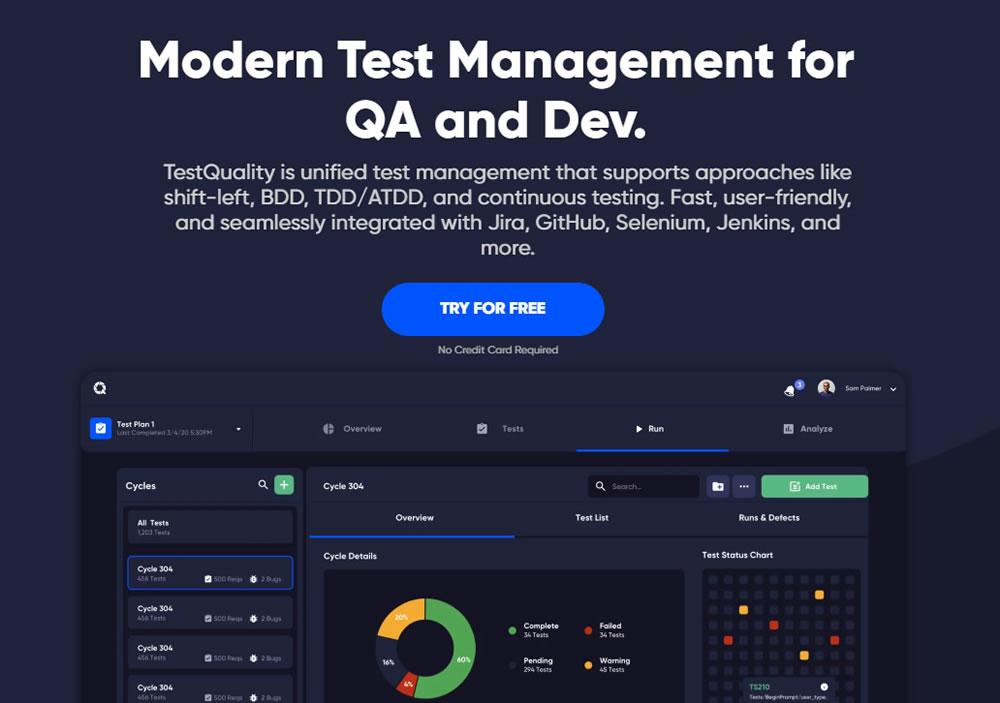In today's rapidly evolving software development landscape, the Rise of AI in Software Engineering and the integration of artificial intelligence into testing processes has become increasingly crucial. As organizations embrace shift-left testing practices, the combination of AI coding assistants and robust test management tools has emerged as a game-changing approach for QA professionals and software developers.
1. The Evolution of Test Management in Software Development
The software testing landscape has transformed significantly with the advent of AI-powered tools. Modern test management requires seamless integration with development workflows, particularly in environments where testing shifts left in the development cycle. TestQuality has positioned itself as a leading solution in this space, offering comprehensive test management capabilities that integrate directly with Jira and GitHub.

2. Understanding AI Coding Assistants
AI-powered coding assistants are revolutionizing the way developers write and manage test cases. These AI tools leverage machine learning and natural language processing to suggest code completions, generate test cases, and enhance overall software quality. Below, we examine three of the most prominent AI coding assistants and their impact on test management.
2.1 GitHub Copilot
GitHub Copilot is an AI-powered coding assistant that provides real-time code suggestions, helping developers generate test cases more efficiently. It integrates seamlessly with popular Integrated Development Environments (IDEs) and understands context to generate relevant test scenarios. Additionally, it supports multiple programming languages, making it a versatile tool for QA professionals.
- Real-time code suggestions and test case generation
- Integration with popular IDEs
- Ability to understand context and generate relevant test scenarios
- Support for multiple programming languages
2.2 Cursor
Cursor "lets you update entire classes or functions with a simple prompt".This AI Code editor enhances the coding experience by being intelligent, and fast by offering advanced code completion and refactoring capabilities. With its deep contextual understanding, it generates specialized test code and improves test case organization. Cursor integrates with existing development workflows, making it a valuable tool for optimizing test management.
- Enhanced code completion and refactoring
- Advanced context understanding
- Specialized test code generation
- Integration with existing development workflows
2.3 ChatGPT:
As we introduced in one of our previous posts "ChatGPT Impact on Software Testing Practices", ChatGPT extends AI assistance beyond coding by leveraging natural language processing for test case creation, scenario ideation, and documentation generation. It provides insights into test strategy and helps optimize code through detailed explanations and recommendations.
- Natural language processing for test case creation
- Test scenario ideation
- Documentation generation
- Code explanation and optimization suggestions
3. Comparative Analysis for Test Management
Each AI assistant brings unique strengths to test management, contributing to different aspects of the software testing process. The following comparisons highlight their distinct advantages:
3.1 GitHub Copilot:
- Excels in generating unit tests
- Strong integration with version control
- Real-time code suggestions during test writing
Real-Case Scenario:
Consider a team developing a REST API with complex validation logic. While ChatGPT might suggest test scenarios in natural language, GitHub Copilot shines by directly generating complete test methods within the IDE. For example, when testing an e-commerce API's payment validation:
def test_payment_validation():
# Copilot automatically suggests:
payment = Payment(amount=-100)
with pytest.raises(ValidationError):
payment.process()GitHub Copilot excels here because it:
- Understands the project's existing test patterns
- Generates contextually relevant assertions
- Maintains consistency with the codebase's testing style
3.2 Cursor:
- Superior code refactoring capabilities
- Enhanced context awareness
- Efficient test case organization
Real-Case Scenario:
When refactoring a legacy test suite with numerous duplicate test cases, Cursor demonstrates superior capabilities. While GitHub Copilot might suggest individual code fixes, Cursor can analyze the entire test file and propose comprehensive refactoring:
# Before (multiple similar test methods)
def test_user_login_email():
# test code
def test_user_login_username():
# similar test code
# Cursor suggests parametrized tests:
@pytest.mark.parametrize("login_type", ["email", "username"])
def test_user_login(login_type):
# consolidated test codeThis is where Cursor outperforms both Copilot and ChatGPT by:
- Identifying patterns across multiple files
- Suggesting structural improvements
- Maintaining test coverage while reducing code duplication
3.3 ChatGPT:
- Versatile test scenario generation
- Natural language test documentation
- Test strategy consultation
Real-Case Scenario:
When developing a new feature requiring comprehensive test coverage, ChatGPT excels at strategic planning. While GH Copilot and Cursor focus on code implementation, ChatGPT can provide a high-level test strategy:
Example conversation:
- User: "How should I test a new two-factor authentication feature?"
ChatGPT's response includes:
- Complete test matrix covering all authentication scenarios
- Edge cases that might be missed by code-focused tools
- Security testing considerations
- Integration test scenarios
- User acceptance testing criteria
This demonstrates ChatGPT's superior ability to:
- Provide comprehensive testing strategies
- Consider non-technical testing aspects
- Generate human-readable test documentation
3.4 Leveraging AI Tools Alongside TestQuality
Although these AI tools function independently, they can be strategically used in conjunction with TestQuality's robust test management platform to enhance your testing workflow:
Strategic Workflow Integration:
- Generate test scenarios and code using AI tools (Copilot, Cursor, ChatGPT)
- Organize and manage these tests effectively within TestQuality's comprehensive test management system
- Utilize TestQuality's Test Plan Builder to structure and document your testing strategy
- Implement AI-generated automated tests through TestQuality's test runner integrations
Practical Implementation Example:
- Use ChatGPT to brainstorm comprehensive test scenarios
- Implement automated tests using GitHub Copilot or Cursor
- Import these tests into TestQuality using JUnit XML reports from test runners like Playwright, Selenium, Cypress or more.
- Manage test execution, track results, and maintain test coverage through TestQuality's overview dashboard.

4. TestQuality: Elevating Test Management with AI Integration
While AI coding assistants provide significant support in test creation, TestQuality enhances the testing process by offering structured test planning, execution, and quality assurance monitoring. By integrating seamlessly with Jira and GitHub, TestQuality ensures that AI-generated test cases are properly managed and traced throughout the development lifecycle.
Remember, effective QA isn’t about finding faults. It’s about fostering a seamless user experience that keeps your system running smoothly. So, next time you submit a pull request, think about the steps you've taken. Have you implemented adequate QA testing?

TestQuality stands out as a comprehensive solution that complements AI coding assistants by providing a robust test planning and test management capabilities.
The TestQuality Test Management offers:
- Test Case Designer
- Test Cycles
- Story linking and tracking
- Share test plans & cases
- Test Execution
- Unified Test Management
- Manual Testing
- Automation Testing (Playwright, Selenium, PyTest, Cucumber, and more test runners).
- Developer Testing (Live 2-way GitHub issue integration, PR Testing, and More
- Exploratory/Adhoc Testing
- PR (Pull Request) Testing
- BDD Testing (Gherkin/Cucumber)
- Flexible roles: Devs, Testers, Test Designers, PMs, Viewers, Custom
- Analytics and Reporting
- Test Configurations
- 30+ Integrations (GitHub, Jira, Selenium, Cucumber, Jenkins, and more)
- Free Jira App (No separate Jira "every seat" pricing!)
- Scriptable CLI
- Robust API
- Automated CC Billing
- Login Authentication (Email, GitHub, and Google)
- Additional API capacity
- SSO Login/Authentication (SSO Domain)
- Custom Procurement Processes
The TestQuality Test Plan Builder Tool offers:
Visual Test Plan Builder: Objectives, Scopes, Approaches, Roles and Responsibilities, Requirements, Deliverables, Milestones and Schedules, and more.
- Structured test plan creation
- Customizable templates
- Bi-directional communication with the Test Management suite and Integration with existing workflows
- Real-time collaboration features
By leveraging TestQuality alongside AI-powered coding assistants, QA teams and developers can streamline their testing processes, ensuring that all test cases align with project requirements and business goals. Sign up today for a 14-day free trial and experience the future of AI-powered test management firsthand.
5. Best Practices for Implementing AI in Test Management
To maximize the benefits of AI-powered testing, organizations should adopt strategic best practices that enhance efficiency, accuracy, and scalability in test management:
- Define Clear Objectives and AI Integration Goals: Establish a well-defined strategy for AI adoption in testing, outlining key metrics and expected outcomes to measure efficiency gains.
- Utilize AI for Intelligent Test Planning: With tools like TestQuality’s Test Plan Builder, teams can create dynamic and customizable plans that leave no critical area untested, ensuring alignment with project goals.
- Leverage the TestQuality In-App Guide for Structured Planning: Unlike generic templates, the TestQuality Test Plan Builder offers step-by-step guidance, covering objectives, scope, testing approaches, and deliverables. This ensures a comprehensive, AI-enhanced planning process.
- Maintain High-Quality and AI-Assisted Documentation: AI-generated test cases and reports should be continuously refined and reviewed to align with business requirements and compliance standards.
- Automate Test Execution and Optimize Based on AI Insights: AI can enhance automation by predicting test failures and suggesting optimizations, helping QA teams focus on high-value testing areas.
- Continuously Review and Adapt AI Models: AI-driven test management should be an iterative process, with frequent assessments to refine AI models, improve predictions, and enhance test effectiveness.
6. Future of AI-Powered Testing
The future of test management lies in the seamless integration of AI assistants with comprehensive test management solutions. As tools like TestQuality continue to evolve, we can expect:
- Enhanced AI-driven test case generation
- Improved predictive analytics for test coverage
- More sophisticated automation capabilities
- Better integration between different testing tools and platforms
Conclusion
The combination of AI coding assistants and robust test management tools represents the future of software quality assurance. While GitHub Copilot, Cursor, and ChatGPT each offer unique advantages, their true potential is realized when integrated with comprehensive test management solutions like TestQuality.
To take your test management process to the next level, sign up for TestQuality’s 14-day free trial and experience the future of AI-driven test planning today.





